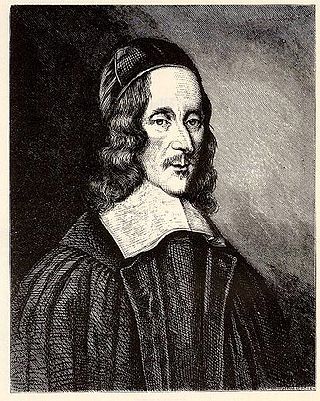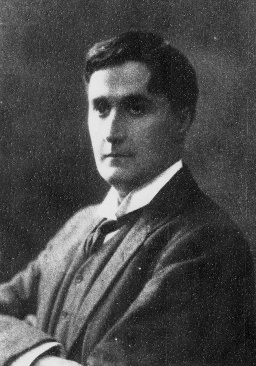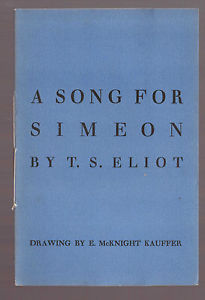
John Donne was an English poet, scholar, soldier and secretary born into a recusant family, who later became a cleric in the Church of England. Under Royal Patronage, he was made Dean of St Paul's Cathedral in London (1621–1631). He is considered the preeminent representative of the metaphysical poets. His poetical works are noted for their metaphorical and sensual style and include sonnets, love poems, religious poems, Latin translations, epigrams, elegies, songs and satires. He is also known for his sermons.

An altar is a table or platform for the presentation of religious offerings, for sacrifices, or for other ritualistic purposes. Altars are found at shrines, temples, churches, and other places of worship. They are used particularly in paganism, Christianity, Buddhism, Hinduism, Judaism, modern paganism, and in certain Islamic communities around Caucasia and Asia Minor. Many historical-medieval faiths also made use of them, including the Roman, Greek, and Norse religions.
Poetry analysis is the process of investigating the form of a poem, content, structural semiotics, and history in an informed way, with the aim of heightening one's own and others' understanding and appreciation of the work.

George Herbert was an English poet, orator, and priest of the Church of England. His poetry is associated with the writings of the metaphysical poets, and he is recognised as "one of the foremost British devotional lyricists." He was born in Wales into an artistic and wealthy family and largely raised in England. He received a good education that led to his admission to Trinity College, Cambridge, in 1609. He went there with the intention of becoming a priest, but he became the University's Public Orator and attracted the attention of King James I. He sat in the Parliament of England in 1624 and briefly in 1625.

The term Metaphysical poets was coined by the critic Samuel Johnson to describe a loose group of 17th-century English poets whose work was characterised by the inventive use of conceits, and by a greater emphasis on the spoken rather than lyrical quality of their verse. These poets were not formally affiliated and few were highly regarded until 20th century attention established their importance.
Richard Crashaw was an English poet, teacher, High Church Anglican cleric and Roman Catholic convert, who was one of the major metaphysical poets in 17th-century English literature.

Bishop Richard Corbet was an English clergyman who rose to be a bishop in the Church of England. He is also remembered as a humorist and as a poet, although his work was not published until after his death.

The Angelus is a Catholic devotion commemorating the Incarnation of Christ. As with many Catholic prayers, the name Angelus is derived from its incipit—the first few words of the text: Angelus Domini nuntiavit Mariæ. The devotion is practised by reciting as versicle and response three Biblical verses narrating the mystery, alternating with the prayer "Hail Mary". The Angelus exemplifies a species of prayers called the "prayer of the devotee".

Sonnet 8 is one of 154 sonnets written by the English playwright and poet William Shakespeare. It is a procreation sonnet within the Fair Youth sequence. As with the other procreation sonnets, it urges a young man to settle down with a wife and to have children. It insists a family is the key to living a harmonious, peaceful life.

Sonnet 22 is one of 154 sonnets written by the English playwright and poet William Shakespeare, and is a part of the Fair Youth sequence.

"Recessional" is a poem by Rudyard Kipling. It was composed for the Diamond Jubilee of Queen Victoria, in 1897.

The Five Mystical Songs are a musical composition by English composer Ralph Vaughan Williams (1872–1958), written between 1906 and 1911. The work sets four poems by seventeenth-century Welsh poet and Anglican priest George Herbert (1593–1633), from his 1633 collection The Temple: Sacred Poems. While Herbert was a priest, Vaughan Williams himself was an atheist at the time, though this did not prevent his setting of verse of an overtly religious inspiration. The work received its first performance on 14 September 1911, at the Three Choirs Festival in Worcester, with Vaughan Williams conducting.
An altar poem is a pattern poem in which the lines are arranged to look like the form of an altar. The text and shape relate to each other, the latter usually giving added meaning to the poem itself. The tradition of shaped poetry goes back to Greek poets writing in Alexandria before the Common Era but most examples date from later and were written by European Christian poets during the Baroque period.

The Sidney or Sidneian Psalms are a 16th-century paraphrase of the Psalms in English verse, the work of Philip and Mary Sidney, aristocratic siblings who were influential Elizabethan poets. The Psalms were published after Philip's death in 1586 and a copy was presented to Queen Elizabeth I of England in 1599. The translation was praised in the work of John Donne.

Ralph Knevet (1600–1671) was an English clergyman and poet.

"Sonnet X", also known by its opening words as "Death Be Not Proud", is a fourteen-line poem, or sonnet, by English poet John Donne (1572–1631), one of the leading figures in the metaphysical poets group of seventeenth-century English literature. Written between February and August 1609, it was first published posthumously in 1633.

"A Song for Simeon" is a 37-line poem written in 1928 by the American-English poet T. S. Eliot (1888–1965). It is one of five poems that Eliot contributed to the Ariel Poems series of 38 pamphlets by several authors published by Faber and Gwyer. "A Song for Simeon" was the sixteenth in the series and included an illustration by avant garde artist Edward McKnight Kauffer. The poems, including "A Song for Simeon", were later published in both the 1936 and 1963 editions of Eliot's collected poems.

Easter Wings is a poem by George Herbert which was published in his posthumous collection, The Temple (1633). It was originally formatted sideways on facing pages and is in the tradition of shaped poems that goes back to ancient Greek sources.
"The Collar" is a poem by Welsh poet George Herbert published in 1633, and is a part of a collection of poems within Herbert's book The Temple. The poem depicts a man who is experiencing a loss of faith and feelings of anger over the commitment he has made to God. He feels that his efforts in committing himself to his faith have been fruitless, and begins to manifest a life for himself without religious parameters. He denounces his commitments and proclaims himself "free". The poem's themes include the struggle with one's beliefs and the desire for autonomy in defiance of religious restriction. The speaker is trying to create his own limits, to lead himself, rather than following God. He tries to convince himself that a life of freedom will bring him the satisfaction that his faith has failed to provide.
"Holy Sonnet XIV" – also known by its first line as "Batter my heart, three-person'd God" – is a poem written by the English poet John Donne. It is a part of a larger series of poems called Holy Sonnets, comprising nineteen poems in total. The poem was printed and published for the first time in Poems in 1633, two years after the author's death. In the 1633 edition the sequence of the poems was different from that found in Herbert Grierson’s edition from 1912; that is why Holy Sonnet XIV features as Holy Sonnet X in older publications. However, the majority of twentieth-century and later editions of Donne's Holy Sonnets are found to prefer and use the order proposed by Grierson and thus include the sonnet as the fourteenth in the cycle.















